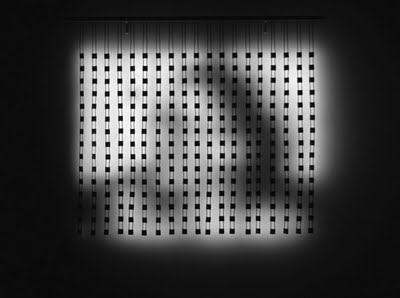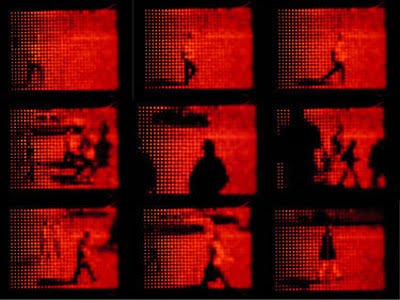Jim Campbell
Saturday, 12 December 2009
Work from his oeuvre.
“Mention Jim Campbell in engineering circles and people will assume you’re talking about one of the leading developers of HDTV. Bring up his name in the art world and the cognoscenti will think you’re discussing the new media pioneer whose ultra-low-resolution LED screens reduce loops of video to the brink of inscrutability. Of course Campbell the engineer and Campbell the artist are the same man, and his apparently divergent careers meet, like converging rays of light, at the point of human perception. But while his HDTV research concerns how much visual information technology can deliver, and how little might thus be left to the imagination, his LED work explores how little visual information the human mind can tolerate–how much the imagination can invent. Campbell’s latest subtle and sublime exhibition, Home Movies (on view at San Francisco’s Hosfelt Gallery March 17-April 28) takes his LED investigations to a new extreme. Instead of shooting his own digital video, Campbell begins with found eight- and sixteen-millimeter footage, already more-or-less anonymous, which he digitally degrades to points of light, flickering across an array of LEDs wired ceiling-to-floor in front of a blank wall. Turned away from the viewer, the LEDs cast shadowy scenes on the wall, showing unidentified figures in motion, or surveying an unknown landscape which, reconstituted in the spectator’s mind, seems uncannily familiar, like the memory of a distant encounter. Campbell’s installation inevitably evokes Plato’s cave while provocatively questioning Plato’s philosophy. More viscerally experienced than the sharpest HDTV, Campbell’s ‘Home Movies’ suggest that the seat of reality is the imagination.” – Jonathon Keats for Rhizome
_________________________
For a sense of how the practice of art is changing at the dawn of the 21st century, you need look no further than Jim Campbell.
A graduate of the Massachusetts Institute of Technology with degrees in electrical engineering and mathematics, Campbell has virtually no formal training as an artist. His art apprenticeship, if you can call it that, consisted of repairing video equipment and, later, designing integrated circuits for video here in Silicon Valley.
The non-intuitive notion of Heisenberg’s principle is that the universe is probabilistic. This means that not only are you unable to measure the position of the electron accurately, but that it does not exist accurately. That, I agree, is totally counter-intuitive.
But at a time when many artists who want to create technologically based art seek a partner who knows the electronics and will leave the creativity to them, Campbell is a whole different thing — a technocrat who discovered early on that he has an artist’s soul.
At the moment, Campbell’s non-art-school vision of art is on exhibit on both coasts. In addition to having a solo show that just opened at the Hosfelt Gallery in San Francisco, he is one of a relative handful of artists from the Bay Area with work in the prestigious Whitney Biennial 2002 at the Whitney Museum of American Art in New York City.
”Up until about six years ago, I didn’t even call myself an artist,” says Campbell, 46, who still puts in one day a week at his job for Sage Inc., a company in Silicon Valley, designing integrated circuits. ”I always knew I wanted to do something with art. In the beginning it had to do with balance, the need to do something that was more poetic and less mathematical. I don’t like to categorize myself.”
Characteristically, Campbell is being too reticent.
Typically, his art uses sophisticated, custom-made electronics where issues about the nature of technology itself — how it affects perception and the changes that it engenders — blend deftly with the ostensible subjects he is exploring, often highly personal themes involving family, time and memory. Elegantly simple, these works often entail some form of motion to be understood, whether it’s flashing light-emitting diodes or the viewer’s own movement.
But the esoterica belie what is at bottom simple and — at its best — affecting work. For ”Portrait of My Father” (1994-95), Campbell connected a framed photograph of his father to electronics that made the portrait vanish and reappear to the audible recorded sounds of the artist’s own breath. A companion piece of his mother tied her portrait to her son’s heartbeat.
In the Hosfelt show, Campbell, who lives in San Francisco, combines ideas about information theory — specifically how little information can be supplied to a viewer and still be understood — with images of the disabled. An unusual and potentially controversial subject, it is one intimately involved with Campbell’s own upbringing: Both his parents were disabled, his father with polio and his mother with arthritis from birth.
For these pieces, Campbell videotaped the gaits of four people with physical handicaps and transposed the images to a board of LEDs. He then placed a sheet of semi-opaque glass in front of the board at different distances. At first, with the vast reduction in the amount of visual information, it’s difficult to discern what the images are. But when one stands at the right distance, the tendency of the human brain to seek meaningful patterns of visual experience helps them snap into focus.
The result is a rumination on the persistence of human frailty in the face of technological progress. It also elicits the viewer’s own feelings about people with disabilities.
”To me, it’s a perfect match of medium and subject,” says Campbell, adding that being raised by a handicapped couple transmitted to him a persistent feeling that they experienced, of being an outsider. ”The technology eliminates all the extraneous stuff.”
Perhaps it was that outsider’s sensibility that left Campbell uncertain about a career while he was at MIT. While pursuing the electrical engineering degrees, he also dabbled in video art and exhibited a piece or two before graduating and taking the job of repairing video equipment that he now describes as well below his abilities. ”I should have stayed there a year but I stayed three.”
All the while, though, he worked on video art in his off hours, in particular a piece about his only sibling, a brother who was schizophrenic and eventually committed suicide. ”It was only about five percent of my time,” he says of his artwork then. ”But it was very intense.”
After unsuccessfully trying to get a gallery in San Francisco to represent him, Campbell finally rented a storefront in the Mission district in 1988 and staged his own exhibit. It drew a visit from Bob Riley, then a curator of newmedia at the San Francisco Museum of Modern Art, who recalled having seen some of Campbell’s student work when he lived in Boston. Two years later, when Riley curated the survey show ”Bay Area Media” at SFMOMA, he remembered Campbell’s work and included him.
”What grabbed me is how thoroughly the work is about the technological medium he is using and its relations to his own perceptual experience,” Riley said recently. ”It changes us, too. We start to see the world in a different way.”
Riley’s attention was enough to launch Campbell’s career. He soon found gallery representation in San Francisco — first the Rena Bransten Gallery and more recently the Hosfelt. There also have been solo shows at progressively larger venues. In 1998, the San Jose Museum of Art presented a well-received exhibition that featured 19 of Campbell’s works. And now the Whitney Biennial, which includes three of the LED pieces.
”I am particularly impressed with Campbell’s ability to combine innovative uses of technology with poetically resonant subject matter,” says Larry Rinder, the chief curator for the Whitney show. ”Despite its complexity, his work has a feeling of effortlessness and dreamy ethereality.”
Now, after more than a decade, Campbell gradually has transformed himself from an engineer to an artist or, perhaps more accurately, into an engineer who just designs what he wants. Starting about two years ago, he started getting grants that have allowed him to cut his job designing circuits to one day a week.
”I’ve gone out and educated myself about art,” says Campbell. ”But I’ve sort of prided myself on not having gone to art school.
”In a way, I feel lucky in that I’m so intensely involved in the technological aspects of the medium that it’s always just a tool. The important thing is what you bring to seeing.” – Jack Fischer for the San Jose Mercury News.


